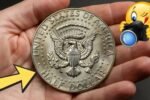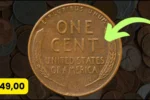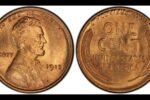1944 Wheat Penny: In the world of coin collecting, small details can mean the difference between a common coin and a priceless rarity. One such example is the 1944 Lincoln Wheat Penny with no mint mark, a coin that at first glance seems ordinary—but in reality, is exceptionally rare and potentially worth thousands.
A Common Year with an Uncommon Error
Most 1944 Lincoln Wheat Pennies were made of copper, following the steel composition used in 1943 to conserve metal for World War II. With more than 1.4 billion pennies minted in 1944, it’s one of the most common dates for Lincoln cents.
However, among the billions produced, a very small number of 1944 pennies were accidentally struck on leftover steel planchets from 1943. These error coins are easy to miss but are incredibly rare and valuable, especially if they were minted in Philadelphia and thus bear no mint mark.
Why the “No Mint Mark” Matters
The absence of a mint mark on a 1944 penny means it was struck at the Philadelphia Mint, which did not use a mint mark at the time. While most of these coins were correctly struck on copper, the steel error versions are anomalies.
Finding a 1944 steel penny with no mint mark is especially significant, as it means the error occurred at the main U.S. Mint facility—adding to its rarity and desirability among collectors.
How Rare Is It?
Experts estimate that fewer than 30 authentic 1944 steel pennies exist from all mints combined. Of those, only a handful are believed to have been struck in Philadelphia, making the no-mint-mark version one of the rarest Lincoln cents ever made.
In past auctions, verified 1944 steel cents with no mint mark have sold for $75,000 to over $100,000, depending on condition.
How to Spot One
If you think you’ve found a 1944 wheat penny with no mint mark, here’s what to check:
-
Color and Material: Copper coins are brown or reddish; steel ones are gray or silver.
-
Magnet Test: Steel pennies will stick to a magnet; copper ones will not.
-
Date and Mint Mark: Look for the date “1944” with no letter beneath it.
What to Do If You Find One
-
Do not clean the coin—this can ruin its value.
-
Store it safely—use a coin holder or soft cloth.
-
Get it authenticated by a professional grading service like PCGS or NGC.
A Penny Worth Paying Attention To
The 1944 Wheat Penny with no mint mark may look like any other, but its potential value makes it worth a second glance. Whether you’re a seasoned collector or someone sorting through spare change, keep an eye out—your next lucky penny could be worth a fortune.
FAQs for “This 1944 Wheat Penny with No Mint Mark is Extremely Rare
Why is the 1944 Wheat Penny with no mint mark rare?
While most 1944 pennies were copper, a few were mistakenly struck on leftover steel planchets from 1943. The no mint mark version means it was made in Philadelphia, and only a few of these steel errors exist.
How can I tell if my 1944 penny is steel or copper?
Use a magnet—steel pennies will stick, copper ones won’t. Also, steel coins have a grayish-silver color, while copper ones appear reddish-brown.
What should I do if I think I found one?
Handle it carefully, don’t clean it, and have it authenticated by a professional coin grading service like PCGS or NGC. It could be worth thousands!




